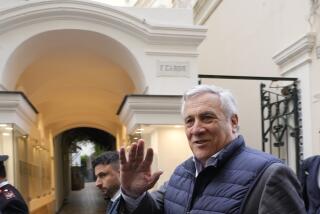G-7 Seeks Signs Good Times in U.S. Will Last
TOKYO â The Group of 7 finance ministers, long used to a diet of Asian crisis, Latin meltdown and Russian chaos, are facing a much different problem at their Tokyo meeting today: what to do with a U.S. economy and stock market that wonât say uncle.
Itâs not that the worldâs top financiers have anything against success. Rather, they fear that the economic health of the globe may be far too dependent on a handful of overvalued U.S. dot-com stocks. Their concern: A sudden reversal of fortune on Wall Street could pare American trips to the mall, leading to a sharp contraction heard around the world.
âYouâre seeing a swing away from worrying about the laggards to worrying about the leader,â said Chris Calderwood, chief economist with Jardine Fleming Securities (Asia) Ltd. âThe other six want to hear from the horseâs mouth that the U.S. isnât going to blow it.â
Other nettlesome issues facing the finance ministers from the U.S., Canada, Japan, Britain, France, Germany and Italy include the rising value of the Japanese yen and strains within the European Union over interest rates.
But with the overall global economy looking better than it has in years, todayâs session is unlikely to produce any dire warnings or dramatic prescriptions. The G-7 ministers donât want to create a self-fulfilling prophecy for the all-important U.S. economy, despite their lingering concerns.
âThey have to be really careful about what they say,â said Craig Chudler, strategist with Nikko Salomon Smith Barney Japan. âIt could really shake the confidence of investors.â
The fears overseas about the U.S. economy are similar to those voiced repeatedly by Federal Reserve System Chairman Alan Greenspan: that stock prices are unrealistically high and that a big run-up in inflation is inevitable.
That combination could quickly slam the brakes on the U.S. economy, which would in turn shrink the worldâs biggest market for exporters in Europe and Asia and threaten those regions.
Granted, the United Statesâ âCinderella economyâ has made fools of the worrywarts repeatedly throughout the past decade--and during periods of far greater global uncertainty at that. And many economists now grudgingly concede that new technology and higher U.S. productivity might be bending the old economic rules.
But warning signs continue to add up as American labor shortages worsen, world oil prices surge and long-term U.S. interest rates spike.
âI think the rules have changed a bit. But at the end of the day, the laws of supply and demand still apply,â said Russell Jones, chief economist with Lehman Bros. Japan. âThere are some real imbalances in the U.S. economy.â
Itâs a given at G-7 meetings that other regionsâ problems always look worse than those at home, and U.S. officials are expected to downplay the risks. Still, what some Americans call a ânew paradigmâ looks increasingly like speculative froth from abroad.
âYou begin to wonder if weâre all living in a fairyland,â said Chris Nailer, a Singapore-based economist with the Economist Intelligence Unit, a business information firm.
As a result, European and Japanese leaders will want reassurance that nearly a decade of U.S. magic has been the consequence of conscious policy. And theyâll want to hear about U.S. contingency plans if there is a sharp correction.
Even if everyone at the table agrees that the U.S. economy is flying on helium, however, itâs not clear what anyone could do about it or where the greatest danger might lie.
âModern bubbles have always been burst by higher interest rates,â said John Shepperd, London-based global markets economist with the Dresdner Kleinwort Benson investment firm. âStill, whatâs the pin that pricks the bubble--the Internet sector, rising rates, some external shock? Itâs not obvious.â
The Federal Reserve is expected to raise U.S. interest rates again at its Feb. 2 meeting in a bid to preempt trouble, with further hikes to follow. Still, the Fed has the difficult task of lowering expectations without creating a rout.
Analysts expect the yenâs rising value against the dollar to be a second key item on the G-7âs agenda. Donât expect results, though.
Japan desperately wants some coordinated help from Europe and the U.S. to drive down the yen for domestic political reasons. But the Americans believe that Japan still needs to raise its growth targets and restructure its financial system.
That was Treasury Secretary Lawrence Summersâ message here Friday in a meeting with Japanese Prime Minister Keizo Obuchi, officials said.
Summers is not about to drive down the yen--a move that would probably worsen the U.S. trade deficit with Japan--during an election year. Nor would Europe, for its own internal structural reasons, welcome any step that might raise the value of the euro, the single currency adopted by 11 EU nations.
The best scenario right now is for Europe and Japan to recover convincingly as the U.S. economy gradually winds down, creating a relatively seamless transition.
Rather than concentrate on slowing U.S. economic growth, however, Summers will almost surely call on Europe and Japan to pick up more of the load.
While Japanâs outlook has improved, itâs still the laggard among industrialized nations.
Europe is expected to come in for some of the same pro-growth, pro-reform nudging. But its economy is better off, so the pressure will probably be lower.
On other fronts, the ministers are expected to touch on the thorny issue of European interest rates. With the European Monetary Union now a year old, strains are starting to show. Individual national economies are grappling with very different growth rates and inflation, yet the group is now subject to unified policies.
The European Central Bank boosted interest rates half a percentage point in November, while the Bank of England, which operates outside the euro zone, raised rates by a quarter-point. The European Central Bank is expected to further raise rates as it tries to balance Germany at the bottom of its business cycle against Spain and others near the top.
*
Hisako Ueno in The Timesâ Tokyo Bureau contributed to this report.
More to Read
Inside the business of entertainment
The Wide Shot brings you news, analysis and insights on everything from streaming wars to production â and what it all means for the future.
You may occasionally receive promotional content from the Los Angeles Times.










